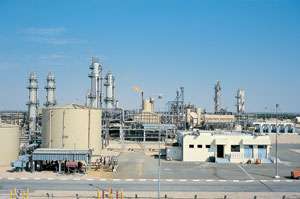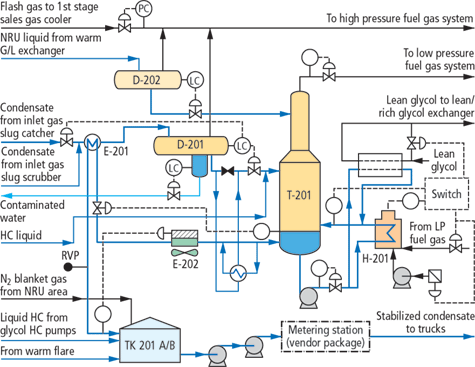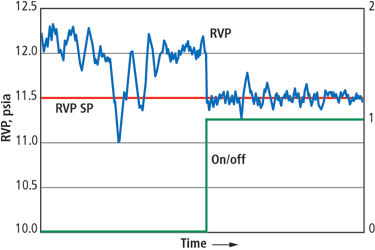BG Tunisia's Advanced Process Control improves condensate product stability
Automation & ControlBG Tunisia's Advanced Process Control improves condensate product stabilityTunisia's leading gas producer implemented the proprietary process control system from Invensys on its major condensate production system to maximize yields, stabilize the process and ensure product quality.Chris Hotblack, Invensys Process Systems BG Tunisia, the leading gas producer in Tunisia, has implemented Connoisseur* Advanced Process Control (APC) from the SimSci-Esscor* unit of Invensys on its gas condensate production system at the Hannibal plant in Sfax, Tunisia, Fig. 1. Project goals were to maximize condensate yields, improve stability of the condensate stabilization process and ensure that product quality limits are adhered to at all times.
Described herein are: 1) Performance improvement study and quality control; 2) How it works and Process description; and 3) Conclusions and operator advantages. PERFORMANCE IMPROVEMENT STUDY; QUALITY CONTROL This APC project was part of a performance improvement study initiated by Invensys, that highlighted a number of areas where improvements could be obtained. Most production plants or assets have potential for performance improvement in many key areas such as safety and environment, quality and economic productivity. The key lies in identifying the most attractive opportunities and designing a “fit for purpose solution” that will continue to deliver benefits in the long-term with minimal maintenance. The performance improvement process is designed to identify the opportunities, and then design, implement and maintain solutions that will deliver the improvement. The supplier also provides proactive support of the APC installation by examining the operation and developing summary reports of performance and issues found. The main reason to implement APC on this unit was product quality and control. BG sells the condensate product with a Reid Vapor Pressure (RVP) defined by the customer. RVP is a standard indicator of volatility, or how quickly a fuel evaporates, and is a key quality control factor, in particular when considering the condensate storage. If the product is too volatile, it will evaporate in warm weather despite venting control. Volatile fractions also ignite easily, incurring a safety risk and more stringent safety regulations. For example, the cost and planning required to conform to ATEX regulations is significant and is one of many factors that lead to the quality specification. The previous method of production relied on infrequent lab sampling to verify the RVP. Online RVP analyzers are available, but can be expensive, so the supplier decided to “kill two birds with one stone.” The important quality measurement was derived through inferential means, that is, the method relies on highly developed statistical modeling. The APC solution provided BG with a stable plant and reduced the RVP variation. HOW IT WORKS Connoisseur APC provides a structured approach to managing process constraints, such as limits on valves and rates of temperature/ pressure change. A model for long-range prediction is used to ensure that constraints on these variables are not violated. This enables maintenance of an operating envelope within which the process is constrained. Recently introduced technology that enhances capability in this area includes quadratic programing. A linear programing technique is combined with a steady state model and a cost function, enabling the optimum operating point to be derived from a strategy based on minimum energy usage, maximum throughput, or a balance between these and/or other objectives. The APC's constrained optimization drives the process to this optimum without violating process constraints such as the RVP limit imposed by the customer. In this instance, a Foxboro* distributed control system was used by the APC to maintain RVP within quality limits and push this to a higher specification, therefore generating greater revenues as condensate throughput was increased. As part of the APC project, Invensys developed a hybrid RVP sensor using both first principle and neural network technology to provide a continuous measurement for control. Lab samples taken on a periodic basis are integrated into the control scheme, improving accuracy and ensuring that product quality is maintained. PROCESS DESCRIPTION Fig. 2 shows a detailed schematic for the condensate process. The liquid hydrocarbon condensate is brought into the plant from the slug catcher and pre-heated in the stabilizer feed/ bottoms exchanger E-201, before entering the stabilizer feed drum D-201. Liquid from the feed drum is fed to the stabilizer T-201 on local flow control. Condensed hydrocarbon liquid from the warm separator in the nitrogen rejection unit (NRU) is also fed to the stabilizer via the NRU liquids flash drum D-202 under level control.
The condensate stabilizer T-201 reduces vapor pressure of the condensate by removing the lighter components. It is a non-refluxed column with 24 trays. Liquid from the stabilizer feed drum is fed at the mid-point on Tray 9 and liquid from the NRU liquids flash drum is fed to the top tray. Overhead vapor from the stabilizer is sent to the low-pressure fuel system through a back-pressure control valve that maintains the tower pressure to set-point. The bottom part of the tower is divided into two sections by a baffle. Liquid from the bottom tray flows into the section that is preferentially pumped through the fired stabilizer reboiler H-201. The two-phase stream from the reboiler is returned to the other compartment where the liquid is separated as stabilized product, and vapor flows up the tower to provide stripping action. The stabilized condensate leaves the stabilizer and is air cooled (E-202) before being sent to the condensate storage tanks TK-201 A/B. ADVANCED PROCESS CONTROL OVERVIEW Connoisseur APC uses a multi-variable control technique based on a linear dynamic process model. The controller uses this model to predict future process behavior from previous sampled process data. Using this predictive model, the controller is able to calculate an optimum set of manipulated variable moves which minimize the error between actual and desired process behavior subject to process constraints. The controller is able to take account of process interactions and overcome process disturbances to reduce the standard deviation of key controlled variables. By providing tighter dynamic control, the controller enables the process to be operated closer to operational constraints with an associated economic benefit. APC control objectives. The main objectives of the Condensate Stabilizer controller are:
The controller uses a real-time online estimate (inferential) of RVP. By controlling more tightly to the target value, excessively high RVP, and associated increased flashing of stabilized condensate in the storage tanks and during tanker transfer, can be minimized, thus reducing losses. The product specification for RVP is 10 – 12 psia. Fig. 3 shows the before-and-after trends of key process variables.
Fig. 4 shows the final control scheme structure consisting of Controlled, Manipulated and Feed-forward variables. The baseline assessment before APC was a mean RVP of 12.25 psia with one standard deviation of 0.43. After APC was installed, the standard deviation dropped to 0.26, enabling control to 11.5 psia with 95% confidence on the 12-psia limit.
RVP inferential sensor. The controller uses a real-time inferential estimate of stabilized condensate RVP. The inferential estimate is implemented directly within Connoisseur's high level programing language as a hybrid of a first-principles model based on the Antoine vapor pressure equation and a radial base neural network. Both the first-principles model and the neural network require the stabilization column base temperature (TI-2035) and top vapor pressure (PC-2045). Compensation for process drift and process measurement error is via feedback from the lab analysis. A weekly lab sample is inserted as a minimum for this purpose. Lab sample introduction to the control scheme is provided via a specially designed interface screen. The operator is provided the option of updating the inferential with the lab sample or rejecting until the next sample is taken. Keeping it clean. As part of the performance improvement project, Invensys delivered a continuous online emissions report, enabling BG to monitor methane, carbon dioxide and freon emissions. This replaces the existing monthly report procedure staff time, eliminating errors and deliberate manipulation of data associated with manual reporting. The online reporting system should prove more accurate, and can immediately indicate any instances of concern, thus aiding the increasing international requirements to demonstrate control of emissions. BG believes that protecting health and safety of its employees, and those affected by its business, and protecting the environment, are critical to continued company success. As such, BG Tunisia acknowledges its industry role in Health Safety and Environment (HSE) leadership, and strives for continual improvement in its performance. Both the Hannibal processing plant and the Miskar production platform meet high environmental standards and are ISO 14001 accredited (Environmental Management System). Reduced operator workload. There are two control room operators making decisions for the plant state, which can be intensive on a busy day. The intelligent APC scheme automatically reduces latent process potential, the “knock-on” effect of which is that plant operators spend less time attending the stabilizer, and greater resource is made available to concentrate on the rest of the plant. CONCLUSIONS The Condensate Stabilization APC application has given BG Tunisia a significant improvement in condensate product stability, resulting in less product losses and reduced fuel gas volumes. In BG's words: “Our objective was to maximize effective throughput and quality of condensate by minimizing the variation of RVP and consistently controlling it at 12 psia, to boost productivity and consistently comply with customer specifications. Optimum process control has been achieved with minimum operator intervention.” Application of this APC to the condensate stabilization unit demonstrates that valuable performance improvements can be achieved with the existing plant without costly capital investment. On the back of this success, Invensys will be working with BG Tunisia to identify similar opportunities in the amine and nitrogen rejection units. BG has been active in Tunisia for more than 15 years and is one of the leading investors in the country, where it has invested around $US 900 million. It is operator and joint permit holder – with the Tunisian state-owned petroleum company Enterprise Tunisienne D'Activites Petrolieres (ETAP) – of the Amilcar and Ulysse exploration permits, and offshore Sfax in the Gulf of Gabes. It is the leading gas producer in Tunisia, supplying more than 50% of the domestic gas demand in 2003. Expansion potential exists for the Miskar field, and BG is seeking Tunisian Government approval to proceed with a number of production enhancement projects.
|
|||||||||||||||||||||||||
- What's new in production (February 2024)
- U.S. operators reduce activity as crude prices plunge (February 2024)
- U.S. producing gas wells increase despite low prices (February 2024)
- U.S. oil and natural gas production hits record highs (February 2024)
- Dallas Fed: E&P activity essentially unchanged; optimism wanes as uncertainty jumps (January 2024)
- Enhancing preparedness: The critical role of well control system surveys (December 2023)







